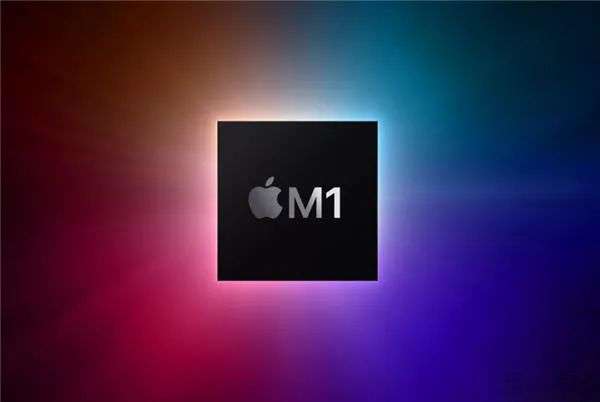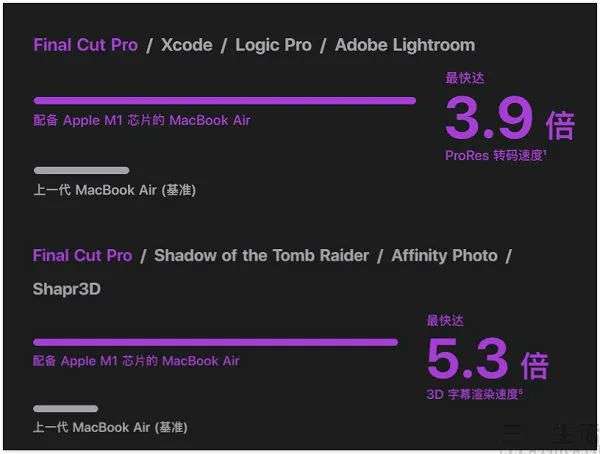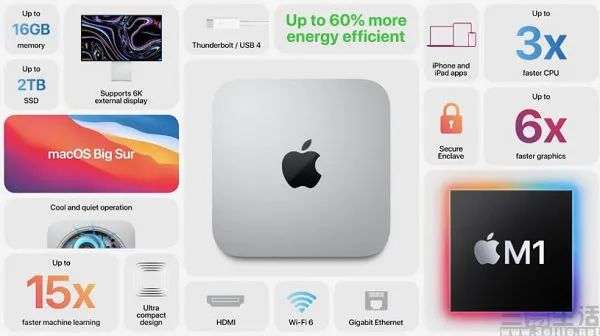In addition to powerful performance, the emergence of Apple’s M1 chip may also break tradition.
Editor’s note: This article is from the WeChat public account “Sanyi Life” (ID: IT-3eLife), Author Sanyi bacteria.
In the early morning of November 11, Apple’s third press conference this fall was held as scheduled in Apple Park. As the outside world predicted before the event, at this press conference, Apple brought the M1 chip, the first product of Apple Silicon, a self-developed chip based on the ARM architecture, which was unveiled at WWDC 2020, and three models equipped with this chip. New Mac products.
As a well-deserved protagonist at the press conference, the M1 chip is made by Apple for the Mac product line. It uses TSMC< /a>’s 5nm process, encapsulating 16 billion transistors, 35.5% more than the 11.8 billion transistors of the A14 bionic chip, and it follows a design concept similar to that of the mobile SoC, combining the central processing unit, graphics processor, Neural network engine, PCIE 4.0 controller, Thunderbolt 4 controller, USB 4 controller, and many other components are all integrated on the same chip.
However, due to the M1’s 4 large cores + 4 small cores CPU architecture and the 8-core GPU design, it has not reached the level of 8 large and 4 small or 6 large and 4 small as previously rumored by the outside world. No wonder some netizens joked, “The A14X that users expect is now being staged in the form of M1.” From the product specifications of M1, it is indeed similar to the previous upgrades of A12 and A12X/Z between it and A14.
Although some friends who watched the full press conference may mutter, “Apple is a young man who does not speak martial arts”, M1 is compared with Intel’s i7-8557U (lower version with 14nm++ process and CoffeeLake architecture) MacBook Pro 13) and i3-8100B (2018 Mac mini). But in fact, relying on the advantages of the manufacturing process and the low-power and high-performance characteristics of the ARM architecture, the outside world believes that even compared to Intel’s current 11-generation Core, the M1 chip may not necessarily be at a disadvantage.
Since the new MacBook Air, 13-inch MacBook Pro, and Mac mini equipped with the M1 chip have not yet announced the specific time to market, the performance of the M1 is still unclear. However, from the perspective of absolute performance, even though this chip, which is mainly focused on low power consumption, does have a certain gap with other desktop-level processors, the appearance of M1 represents the reality of the accumulation of good practices on the mobile side and counterattack the desktop side. The unquestionable UWP may eventually be realized on Apple, and the ecological unification that has been shouting for years may finally be coming.
In the eyes of the outside world, the M1 chip is undoubtedly the beginning of Apple’s device integration. In the future, the Mac, iPad, and iPhone device systems may be highly unified, and an application can directly face iOS, iPadOS, and macOS. Launched, and users will only feel the difference between screen size and operating performance. Under such circumstances, it is not only developers who benefit the most. After all, the result of the decline in development costs is that the attractiveness of the entire ecology is increasing. For Apple, which is taking a closed route, this is obviously very important.
And the birth of M1 is not only a symbol of Apple’sIn addition to tel and AMD, a new force and route in the desktop processor market has emerged. The biggest highlight of the M1 chip based on the ARM architecture is its high energy consumption ratio. According to Apple’s official statement, the M1’s CPU and GPU want to achieve the same performance as the “latest notebook processor”, and only need 1/4 and 1/3 Power consumption.
As we all know, in the current notebook computer market, stacking is something that many manufacturers are doing, and they usually use better heat dissipation design to achieve performance release under high power. In fact, this is because the power consumption and performance of the processor is an exponential function. As performance continues to be squeezed, the power consumption will increase exponentially, which will cause significant heating, which will form a In the situation of constant “involution”, only “stacking” can obtain better performance. However, in the current situation of relatively slow progress in basic materials science, one day there may be a situation where there is no pile, and the emergence of M1 has undoubtedly found a new development route for the industry.
Currently, the traditional x86 processors on notebook computers, whether Intel or AMD products, consume relatively higher power in low-load application scenarios, which makes their battery life inherently limited. However, laptops originally used as mobile devices have a concept of travel weight, that is, the total weight of the machine (including battery) + power adapter. After the updated MacBook Air and 13-inch MacBook Pro replaced the M1 chip, the battery life has been greatly improved, which means that it can get rid of the need to connect to the power supply. The stereotype that the adapter can only be used also makes it a real mobile device like a smart phone.
In addition to freeing laptops from battery life, the SoCization of desktop processors on the M1 chip and the introduction of large and small core designs represent more feasible changes. Since the M1 chip adopts a unified memory architecture, its central processing unit, graphics processor, neural network engine, cache, and DRAM memory are all connected together through the Fabric high-speed bus, and the memory integrated on the SoC substrate can be directly regarded as A large-capacity L4 cache uses a strategy of sacrificing scalability for throughput, which also brings higher bandwidth and lower latency.





